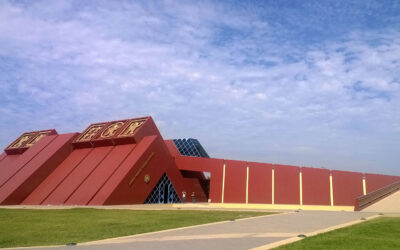El Brujo Complex
The Lady of CaoEl Brujo and the Lady of Cao
El Brujo and the Lady of Cao are two closely linked phrases; in this article, we will uncover their true history.
El Brujo is the name of the archaeological complex made up of Huaca Cao Viejo, Huaca El Brujo, and Huaca Prieta. The complex is located in the Chicama Valley, Magdalena de Cao, facing the ocean, about 60 km north of Trujillo city.
Huaca Cao Viejo has been the most thoroughly studied. Archaeological research began in 1990, sponsored by the Wiese Foundation.
Huaca Cao Viejo was built by the Moche culture in the 1st century A.D. and was abandoned around the 600 years, shortly before a major El Niño event. The temple features seven superimposed structures, resulting from the burial of older buildings. This was possibly done in response to disasters, such as torrential rains or earthquakes.
During its final period of use, the temple reached a height of 30 meters and an average base of 120 meters per side. In front of the temple is a large plaza measuring 140 meters long by 75 meters wide, oriented to the north. From here, one can see the stepped façade where the first evidence of polychrome reliefs was found. The designs depict naked prisoners with ropes around their necks, dancers holding hands, and the Decapitator, carrying the head of a prisoner.
Excavations inside the temple have uncovered ceremonial courtyards exceptionally well-preserved, retaining the vividness of their colors. As in the Huaca de la Luna, priests were buried within each structure.

ARCHAEOLOGICAL DISCOVERIES
Archaeologists found the tomb of a figure similar to the Lord of Sipán, accompanied by 15 individuals, including 11 women. Unfortunately, the tomb had been looted, so the body and main offerings were not recovered.
After the Moche abandoned the site, the temple retained its ceremonial function. The Lambayeque used the main plaza as a cemetery. From this period, a large number of mummies buried in the fetal position have been discovered. By the time the Spanish arrived, there was a large population, and for that reason, Dominican priests built a Christian church over the ancient plaza, the remains of which have withstood the passage of time.
One of the most important discoveries in Peruvian archaeology is the tomb of the Lady of Cao, a Moche woman ruler who, like the Lord of Sipán, played a leading role in that society. What made the find extraordinary was that her body was intact, with preserved skin showing tattoos on her arms depicting snakes and spiders.

Recent Posts
Sipan Royal Tombs Museum
The Sipan Royal...
Cumbemayo Aqueduct
It is located 20...
The Lambayeque Civilization
The Lambayeque...




0 Comments